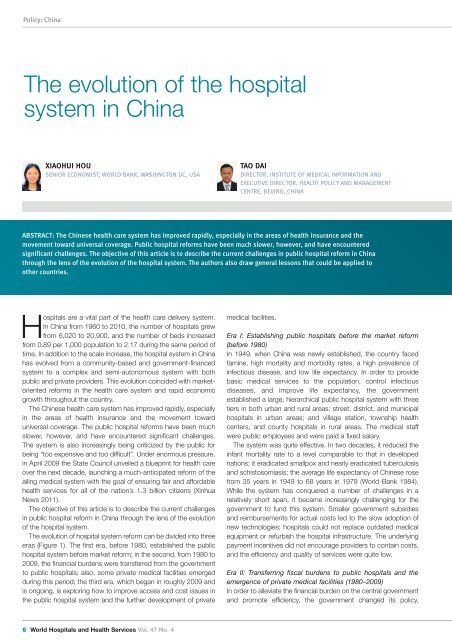web_vol47 4.pdf - International Hospital Federation
web_vol47 4.pdf - International Hospital Federation
web_vol47 4.pdf - International Hospital Federation
You also want an ePaper? Increase the reach of your titles
YUMPU automatically turns print PDFs into web optimized ePapers that Google loves.
Policy: China<br />
The evolution of the hospital<br />
system in China<br />
XIAOHUI HOU<br />
SENIOR ECONOMIST, WORLD BANK, WASHINGTON DC, USA<br />
TAO DAI<br />
DIRECTOR, INSTITUTE OF MEDICAL INFORMATION AND<br />
EXECUTIVE DIRECTOR, HEALTH POLICY AND MANAGEMENT<br />
CENTRE, BEIJING, CHINA<br />
ABSTRACT: The Chinese health care system has improved rapidly, especially in the areas of health insurance and the<br />
movement toward universal coverage. Public hospital reforms have been much slower, however, and have encountered<br />
significant challenges. The objective of this article is to describe the current challenges in public hospital reform in China<br />
through the lens of the evolution of the hospital system. The authors also draw general lessons that could be applied to<br />
other countries.<br />
<strong>Hospital</strong>s are a vital part of the health care delivery system.<br />
In China from 1960 to 2010, the number of hospitals grew<br />
from 6,020 to 20,900, and the number of beds increased<br />
from 0.89 per 1,000 population to 2.17 during the same period of<br />
time. In addition to the scale increase, the hospital system in China<br />
has evolved from a community-based and government-financed<br />
system to a complex and semi-autonomous system with both<br />
public and private providers. This evolution coincided with marketoriented<br />
reforms in the health care system and rapid economic<br />
growth throughout the country.<br />
The Chinese health care system has improved rapidly, especially<br />
in the areas of health insurance and the movement toward<br />
universal coverage. The public hospital reforms have been much<br />
slower, however, and have encountered significant challenges.<br />
The system is also increasingly being criticized by the public for<br />
being “too expensive and too difficult”. Under enormous pressure,<br />
in April 2009 the State Council unveiled a blueprint for health care<br />
over the next decade, launching a much-anticipated reform of the<br />
ailing medical system with the goal of ensuring fair and affordable<br />
health services for all of the nation’s 1.3 billion citizens (Xinhua<br />
News 2011).<br />
The objective of this article is to describe the current challenges<br />
in public hospital reform in China through the lens of the evolution<br />
of the hospital system.<br />
The evolution of hospital system reform can be divided into three<br />
eras (Figure 1). The first era, before 1980, established the public<br />
hospital system before market reform; in the second, from 1980 to<br />
2009, the financial burdens were transferred from the government<br />
to public hospitals; also, some private medical facilities emerged<br />
during this period; the third era, which began in roughly 2009 and<br />
is ongoing, is exploring how to improve access and cost issues in<br />
the public hospital system and the further development of private<br />
medical facilities.<br />
Era I: Establishing public hospitals before the market reform<br />
(before 1980)<br />
In 1949, when China was newly established, the country faced<br />
famine, high mortality and morbidity rates, a high prevalence of<br />
infectious disease, and low life expectancy. In order to provide<br />
basic medical services to the population, control infectious<br />
diseases, and improve life expectancy, the government<br />
established a large, hierarchical public hospital system with three<br />
tiers in both urban and rural areas: street, district, and municipal<br />
hospitals in urban areas; and village station, township health<br />
centers, and county hospitals in rural areas. The medical staff<br />
were public employees and were paid a fixed salary.<br />
The system was quite effective. In two decades, it reduced the<br />
infant mortality rate to a level comparable to that in developed<br />
nations; it eradicated smallpox and nearly eradicated tuberculosis<br />
and schistosomiasis; the average life expectancy of Chinese rose<br />
from 35 years in 1949 to 68 years in 1979 (World Bank 1984).<br />
While the system has conquered a number of challenges in a<br />
relatively short span, it became increasingly challenging for the<br />
government to fund this system. Smaller government subsidies<br />
and reimbursements for actual costs led to the slow adoption of<br />
new technologies; hospitals could not replace outdated medical<br />
equipment or refurbish the hospital infrastructure. The underlying<br />
payment incentives did not encourage providers to contain costs,<br />
and the efficiency and quality of services were quite low.<br />
Era II: Transferring fiscal burdens to public hospitals and the<br />
emergence of private medical facilities (1980–2009)<br />
In order to alleviate the financial burden on the central government<br />
and promote efficiency, the government changed its policy,<br />
6 World <strong>Hospital</strong>s and Health Services Vol. 47 No. 4
















